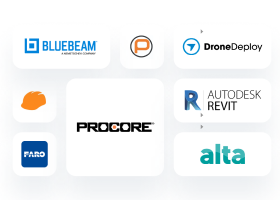Revolutionize Your Construction Game with Cutting-Edge Engineering Tech
Construction engineering technology is a collection of tools used to enhance productivity. It supports the design, planning, construction, and management of infrastructure, simplifying the building process and reducing the chance of issues.
Construction engineering technology helps teams adhere to engineering and technical standards throughout all project phases , from planning through construction. It includes managing everything related to a construction engineering job, such as developing and managing different aspects of the project, such as:
- Applicable building codes
- Building information modeling (BIM)
- Blueprints
- Building site inspections
- Codes
- Construction personnel supervision
- Cost Estimating
- Environmental assessments
- Land use guidance
- Plans and specifications
- Project scheduling
- Report preparation
- Safety regulations
- Site supervision
- Supply procurement and logistics
- Surveying
Construction engineers are a hybrid between civil engineers and construction managers. They focus on the design and construction management of highways, bridges, airports, railroads, buildings, dams, and utilities.
Construction engineering technology is purpose-built to streamline complex jobs and drive efficiency into the projects that they work on and run. Construction engineering technology is used by everyone involved in a project, including:
- Estimators
- General contractors
- Layout specialists
- Management
- Material specialists
- Planners
- Project managers
- Subcontractors
Let’s jump in and learn:
- What Are Construction Engineering Technologies?
- What Is the Difference Between Construction Engineering Technology and Civil Engineering?
- What Is the Difference Between Construction Engineering and Construction Management?
- Tips for Implementing SaaS in Construction
- Construction Engineering Technology Provides Critical Tools for a Vital Role
What Are Construction Engineering Technologies?
There are many types of construction engineering technology—these range from software to sophisticated tools. Several examples of construction engineering technology give a sense of the range and variety, which include:
3D Printing
The versatility of 3D printing makes it a vital arrow in the construction engineering technology quiver. It can be used to prefabricate materials for a project and delivered directly to a jobsite and be ready to use immediately. 3D printing not only saves time but also allows for on-demand production of the exact materials needed, reducing waste and saving money on overages, transportation, and storage.
Artificial Intelligence and Machine Learning
Artificial Intelligence (AI) and machine learning (ML) are essential construction engineering technology capabilities for construction managers. They are used to analyze data (e.g., from cameras and sensors) to identify risks or hazards and alert managers. AI and ML are also utilized for schedule-related tasks, facilitating automation that prevents issues, such as delays and conflicts.
Autonomous Equipment
Autonomous and semi-autonomous machines include a range of construction staples, such as dump trucks, bulldozers, and loaders. Purpose-built robots handle physically demanding tasks like finishing drywall. These construction engineering technologies provide many benefits, from reducing worker stress and fatigue to improving job site safety.
Building Information Modeling Software
Building information model (BIM) software is used to create and manage all the digital details about every aspect of a construction project. With BIM, contractors can build a project virtually before starting any physical work, allowing teams to automate clash detection and complete design and documentation.
BIM helps teams gain advanced visibility into potential problems and identify areas for optimization, including enhanced collaboration, reduced waste related to unused materials, and more accurate planning. BIM ensures better project outcomes, such as on-time completion and cost savings.
Computer-Aided Design
Computer-aided design, or CAD, has long been a critical construction engineering technology, and CAD software has become the de facto alternative to hand drawings. With CAD, 2D or 3D drawings can be created and easily shared throughout the lifecycle of a project. Among its many benefits, CAD makes it much easier to update building plans.
Data Collection Applications
Data collection apps help construction organizations collect valuable information quickly and more accurately from everywhere that teams work—from offices to job sites by project managers and subcontractors.
This information can then be integrated into other systems and processes to boost efficiency and productivity by streamlining workflows. In addition to reducing data entry errors, data collection apps also save time. Data collection apps offer a variety of entry interfaces, including online forms that can be filled from a smartphone or web browser, as well as automated data capture from other devices (e.g., sensors and cameras).
Drones
One of the fastest-growing tools in the construction engineering technology area, drones not only enhance what people can do but go further to do things previously not feasible. For instance, drones can conduct surveys faster and far less expensive than aerial imaging.
High-resolution cameras and data collection instruments allow drones to gather data needed to create interactive 3D or topographical maps and models and take volume measurements. In addition, they can be used to inspect places that are difficult or unsafe to reach, such as bridges or steep terrain. The data collected by drones is also highly accurate and not subject to human error.
Intelligent Compaction and Paving Control
With intelligent compaction and paving controls, the process of creating roads is more accurate and consistent by employing technology. It allows for better control over cutting depths and ensures that the paver is precisely aligned, which results in a more uniform surface and improves efficiency, grading, and speed.
Laser Scanning
One of the most used construction engineering technologies is laser scanning, which provides accurate information about a site. It improves construction accuracy and quality by giving construction managers access to detailed information that facilitates site assessments, planning, and detailing. Construction managers can use 3D laser scanning to reduce manual labor and errors, resulting in on-time, on-budget projects.
Modular Construction
Modular construction is like prefabrication. However, while prefabrication uses some manufactured components and builds the rest on-site, modular construction procures nearly all of a structure’s components from an off-site manufacturer, then assembles the pieces on-site. Like prefabrication, modular construction saves time and money, and improves consistency and quality.
Prefabrication
Prefabrication is a type of construction that involves manufacturing a structure’s components at a different site and then transporting them to the construction site. Using prefabrication expedites construction, saves time, and ensures consistent quality.
Site Positioning Systems
With site positioning systems, construction teams can precisely map the building site. This construction engineering technology plays a vital role in construction and mining because they allow teams to complete preliminary site analysis without waiting for surveyors. Site positioning systems reduce operational costs, optimize processes, and help streamline construction timelines.
Virtual Reality
Construction engineering technology also includes virtual reality. BIM often uses this technology to help navigate and visualize complex projects. An example is creating a building design with BIM and then using virtual reality to visualize a walkthrough. Virtual reality provides a realistic view of what the project will look like when it is completed. This helps avoid mistakes and change orders.
Wearables
Wearables are a construction engineering technology. They are used in various ways, from hands-free communication and location tracking to monitoring vital signs and oxygen levels. Wearables are found in everything from protective glasses to safety vests.
Weighing Solutions
Construction engineering technology includes weighing tools, which play an important role in construction projects. Precise weight calculations are essential in a construction project to prevent inaccuracies that can increase the risk of accidents.

What Is the Difference Between Construction Engineering Technology and Civil Engineering?
Civil engineering focuses on designing, planning, analyzing, and implementing a construction project. It includes technical considerations, such as load-bearing structures, construction building codes, and the techniques used during construction.
Construction engineering relates more to the day-to-day management of a construction site and is more hands-on, focusing on construction materials, planning, and project management.
What Is the Difference Between Construction Engineering and Construction Management?
Construction engineering involves civil engineers in a project’s design and implementation phase. On job sites, construction engineers sometimes are engaged in physical building tasks but more commonly oversee the project.
Construction management, a specialized project management, oversees all aspects of a building project from start to finish. Construction managers ensure smooth integration and interactions between owners, architects, and general contractors.
Tips for Implementing SaaS in Construction
There are several SaaS products for the construction industry, and others focus on construction engineering technology. Among them are tools for:
- Accounting
- BIM design
- Client Relationship Management (CRM)
- Health and Safety
- Logistics
- Project Management
- Quality control
A priority tool when implementing construction engineering technology or other solutions is security. Security protocols should include the following:
- Access controls for files and data
- High-level encryption
- Networking firewalls
- Procedures and controls to ensure that sensitive information is protected
Tips to ensure a successful implementation of SaaS in construction are as follows.
1. Assign someone responsible for implementing construction engineering technology in a SaaS model to ensure that someone, ideally a team, understands the ins and outs of the new system and its capabilities.
2. Define the organization’s needs, such as gaps in capabilities and systems that need to be updated or replaced because they are inefficient or difficult to use.
Determine what pricing model works best for the organization. Considerations when assessing pricing models should include:
- The degree of scalability that is required.
- How much cloud storage space will be needed—now and over time.
- What team members will use the system, and from which locations.
- Does fixed-rate or pay-per-use work best.
4. Look at the math to determine if SaaS is the right direction versus an on-premises solution. In some cases, the processes that will be replaced or enhanced can be run more cost-effectively with an on-premises solution rather than a cloud-based one.
Each organization is different, so take the time to confirm that the ROI makes sense before deciding whether to go with on-premises versus SaaS.
Construction Engineering Technology Provides Critical Tools for a Vital Role
The adoption of construction engineering technology has significantly increased efficiency and productivity. It gives construction engineers, critical players on a construction team, specialized tools designed to meet their unique needs.
Egnyte has experts ready to answer your questions. For more than a decade, Egnyte has helped more than 16,000 customers with millions of customers worldwide.
Last Updated: 23rd February, 2023



